ISSN ONLINE(2278-8875) PRINT (2320-3765)
ISSN ONLINE(2278-8875) PRINT (2320-3765)
N.Venkata Rao1, K.Sarada2
|
| Related article at Pubmed, Scholar Google |
Visit for more related articles at International Journal of Advanced Research in Electrical, Electronics and Instrumentation Engineering
Price estimation is becoming increasingly relevant to producers and consumersin the new competitive electric power markets. Both for spot markets and short termcontracts, price forecasts are necessary to develop bidding strategies in order to maximizetheir benefits and utilities, respectively. Price estimation has become a very valuable toolin the current upheaval of electricity market deregulation. It plays an important role inpower system planning and operation, risk assessment and other decision making. Thisthesis provides a method for predicting hourly prices in the day-ahead electricity marketusing Fuzzy Logic (FL) technique, based on a similar days approach. The describedapproach uses the Mamdani Inference Method in Fuzzy Editor. In this way, it iscarried out for twenty four steps to predicted next 24 hour prices. The proposed method isexamined on the PJM electricity market. The results obtained through the simulationshow that the Fuzzy Logic model can provide efficient, accurate and betterresults.
Keywords |
| Electricity market, price estimation, Fuzzy Logic PJM market. |
INTRODUCTION |
| Deregulation has a great impact on the power industry nowadays. In a deregulated environment electricity is supplied in a competitive market, and the pricing system plays an important role. Nodal price has become one of the most popular modes for energy pricing. Nodal price can reflect the electricity value at a given node and may be discriminated at different nodes in a power network. Similarly, locational marginal prices (LMPs) based on the nodal prices for nodes are presently used in some power markets. |
| During the last two decades, the electric power industry around the world has undertaken significant restructuring. With the introduction of restructuring into the power industry two major objectives remains same in establishing an electricity market. First one is ensuring a secured operation and second one is facilitating an economical operation. Security could be ensured by utilizing the diverse services available to market. The price of electricity has become the focus of all activities in the power market as price estimation that plays a crucial role in establishing proper economical operation is still an issue. Many factors could impact theelectricity price in which some factors are more dominant than others. Some of the factors considered in electricity price in literature are: (a) Time (b) Reserve (c) Price (d) Load. In general, the main factor driving the electricity price is power demand. |
| In the USA, the PJM (Pennsylvania, New Jersey, and Maryland) spot market is coordinated by an independent system operator (ISO) who has ensured secure, economic, and efficient operation as well as determining all LMPs according to voluntary bids and bilateral transactions since April 1998. The LMPs reveal important information that is helpful for the market participants to develop their bidding strategies, it is also crucial indicator for the security coordinator to perform market re-dispatch once congestion occurs. Therefore LMP estimation is essential in a deregulated market. It has been found that the characteristics of LMPs in the PJM electric market are non-stationary and nonlinear. The three following observations can be made. |
| 1. The daily load curves have similar patterns whereas the daily LMP curves are volatile. |
| 2. There are some abrupt changes in the LMP curves. The LMP values usually reach peaks around 9a.m. and 20p.m. |
| 3. The LMP and load values are low at night. |
| The reason for the LMP curves being volatile is that the LMP depends on the system operating conditions, e.g. congestion condition and outage. |
| On the other hand, Fuzzy Logic have been considered as an effective approach for solving a variety of power engineering problems: Fuzzy Logic is used for short-term load estimation. Fuzzy Logic is also developed for system marginal price (SMP) estimation, market clearing price (MCP) and market clearing quantity (MCQ) estimation. The advantages of the Fuzzy method in price estimation technique with respect to other techniques reported in the technical literatures are: better accuracy; simplified Fuzzy Method with lesser number of inputs; good in volatility cases; and perform well for multiple seasons. To evaluate the performance of the proposed model, Mean Absolute Percentage Error (MAPE) is calculated.A lot of methods have been reported for price prediction of the electricity markets, especially in the last decade. Some of these methods are basically the short-term load forecasting(STLF) methods. However, electricity prices are usually morevolatile than hourly loads. Hence, the price prediction ismore complex than the STLF. Methods based ontime series or Fuzzy Logic (FL) are more common for electricity price estimation due to their more flexibility and ease ofimplementation.Time series model, i.e., autoregressive integrated movingaverage (ARIMA), has been used to predict price in Spanishand Californian electricity markets. Nogales et al. have proposed time series models, including dynamic regressionand linear transfer function models for short-termprice forecasting. The main drawback of time-series model isthat they are usually based on the hypothesis of stationary;however, the price series violate this assumption. Anotherkind of time-series models like Generalized AutoregressiveConditional Heteroskedastic (GARCH) and Input-Output Hidden Markov models (IOHMM) have been developed inorder to solve the above problem. However, their applicationto electricity price prediction encounters difficulty. A rapidvariation in load can have a sudden impact on the hourly price.The time-series techniques are successful in the areas wherethe frequency of the data is low, such as weekly patterns, but they can be problematic when there are rapid variations. |
PRICE EASTIMATION USING FUZZY LOGIC |
| There is a growing tendency towards unbundling the electricity system. This is continually confronting the different sectors of the industry (generation, transmission, and distribution) with increasing demand on planning management and operations of the network. The operation and planning of a power utility company requires an adequate model for electric power load price estimation. Deregulation has a great impact on the power industry nowadays. In a deregulated environment electricity is supplied in a competitive market, and the pricing system plays an important role. Nodal price has become one of the most popular modes for energy pricing. Nodal price can reflect the electricity value at a given node and may be discriminated at different nodes in a power network. Similarly, locational marginal prices (LMPs) based on the nodal prices for nodes are presently used in some power markets. |
| During the last two decades, the electric power industry around the world has undertaken significant restructuring. With the introduction of restructuring into the power industry, two major objectives remain same in establishing an electricity market. First one is ensuring a secured operation and second one is facilitating an economical operation. Security could be ensured by utilizing the diverse services available to market. The price of electricity has become the focus of all activities in the power market as price estimation that plays a crucial role in establishing proper economical operation is still an issue. Many factors could impact the electricity price in which some factors are more dominant than others. Some of the factors considered in electricity price in literature are: (a) Time (b) Reserve (c) Price (d) Load. In general, the main factor driving the electricity price is power demand. |
| In the USA, the PJM (Pennsylvania, New Jersey, and Maryland) spot market is coordinated by an independent system operator (ISO) who has ensured secure, economic, and efficient operation as well as determining all LMPs according to voluntary bids and bilateral transactions since April 1998. The LMPs reveal important information that is helpful for the market participants to develop their bidding strategies, it is also crucial indicator for the security coordinator to perform market re-dispatch once congestion occurs. Therefore LMP estimation is essential in a deregulated market. It has been found that the characteristics of LMPs in the PJM electric market are non-stationary and nonlinear. The three following observations can be made. |
| 1. The daily load curves have similar patterns; whereas the daily LMP curves are volatile. |
| 2. There are some abrupt changes in the LMP curves. The LMP values usually reach their peaks around 9a.m. and 20p.m. |
| 3. The LMP and load values are low at night. |
| The reason for the LMP curves being volatile is that the LMP depends on the system operating conditions, e.g. congestion condition and outage. |
| In recent years, estimation method based on artificial intelligence techniques have been reported in many papers, and especially, Fuzzy Logic have received much attention as they provide good solutions to model complex non-linear relationships much better than the traditional linear models. Fuzzy Logic is used for solving the short-term load forecast problems. Fuzzy Logic is also used to forecast system marginal price (SMP), market clearing price (MCP). In price estimation applications, the main function of Fuzzy Logic is to predict price for next half-hour, hour(s), day(s) or week(s). Although many types of FIS models have been reported in papers, the most popular one for price estimation is the Mamdani inference method. In this analysis, new approach is proposed to forecast hourly electricity prices in the PJM day- ahead market using Fuzzy Logic (FL). It is a multistep approach based on one output node, estimation price a single step ahead, and the FL is applied using the previous prediction as input for the subsequent forecasts. In this way, it is carried out for twenty four steps to predict next 24 hour electricity prices. |
| The advantages of this price estimation technique with respect to other techniques reported in the technical literatures are: better accuracy; Mamdani inference method with lesser number of inputs; good in volatility cases; and perform well for multiple seasons. To evaluate the performance of the proposed model, Mean Absolute Percentage Error (MAPE) is calculated. |
| The input variables of the fuzzy structure for price estimation to predict next half-hour, hour(s), day(s) or week(s) and the proposed system structure are shown below, |
| The inputs given are, |
| 1. Hourly price data |
| 2. Hourly load data |
| 3. Min/ Max/Average daily temperature etc. |
A.Mamdani Inference Method: |
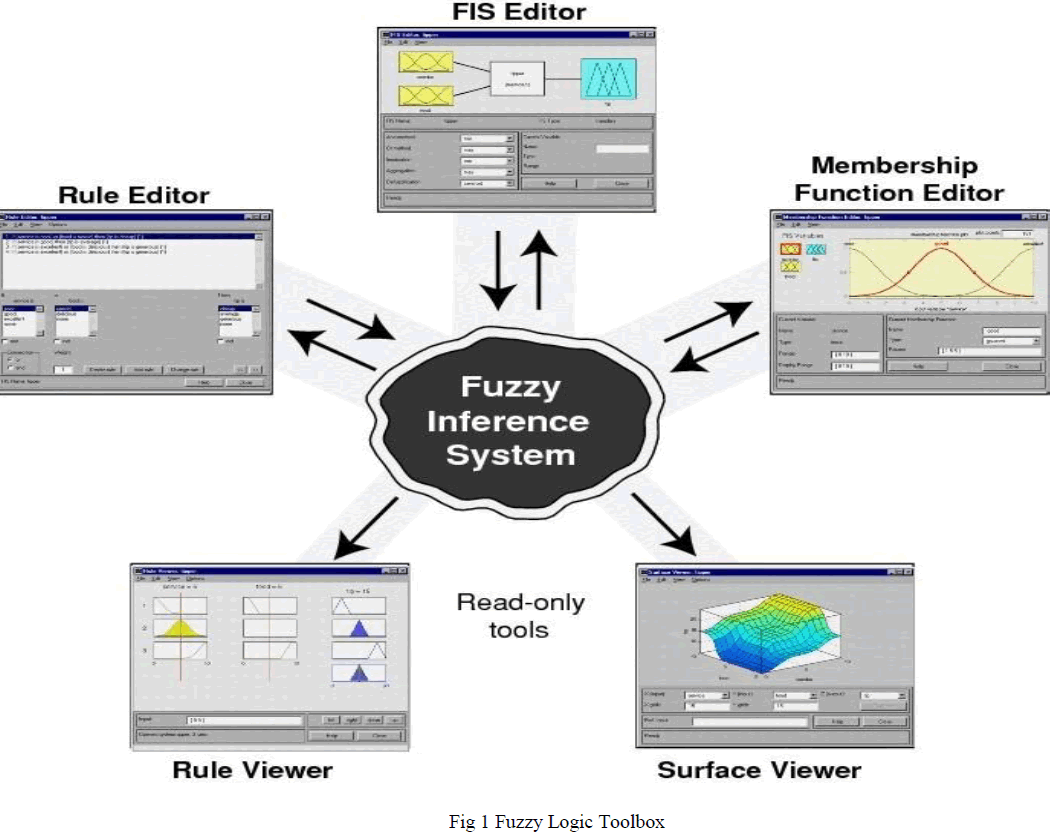 |
| Advantages of the Mamdani Method |
| 1) It is intuitive. |
| 2) It has widespread acceptance. |
| 3) It is well suited to human input. |
B.Preprocessing of Training Data: |
| The data employed for training and testing the Fuzzy Logic is obtained from the PJM website for the period of January- May 2006. Sets of data include hourly price and load data. One day per month (January-May) of year 2006 is studied to validate the performance of the Fuzzy Logic model. Weekdays and Weekends are selected for daily estimates. |
| To evaluate the performance of the proposed model, the most widely used mean absolute percentage error (MAPE) is adopted. However, when used in its present form for electricity price estimation. MAPE could create errors because of the perceived behaviour of electricity price. For example, the price of electricity volatile. It can rise to tens of or even hundreds of times its normal values in other periods. Accordingly, MAPE could reach the extreme values in those cases to avoid this adverse effect; the following MAPE definition has been used, |
 |
| The comparisons of estimated prices obtained from MamdaniâÃâ¬ÃŸs inference method with actual price are observed by designing and train the Fuzzy Logic in MATLAB. |
| The performance of the predictions resulting from the proposed Fuzzy Logic is further evaluated by computing forecast mean square error (FMSE).This parameter is the square root of the average of 24 (daily) square differences between the predicted prices and the actual ones, i.e., |
 |
SIMULATION RESULTS |
| The results obtained from testing the Mamdani Inference Method on new data for 24 hours of a day over a considerable range of period are presented below in graphical form. Each graph shows a plot of both the “predicted” and “actual_ price in $/MWh values against the hour of the day. The Mean Absolute Percentage Error MAPE (%) between the “predicted” and “actual” loads for each day has been calculated. Overall, the above error values translate to an absolute mean error of 9% during weekday in this study and similarly for weekend the MAPE value is much lower 8% is obtained in this study. Hence, the proposed method compare favourably well with their approach in weekend and weekday. This represents a high degree of accuracy in the ability of Fuzzy Logic to forecast electric load. |
| Fig.2 shows the price estimation results for January 21, 2006. The forecast results obtained from the Fuzzy Logic is quite nearer to the actual price values, especially after 3 p.m. |
| Similarly, the price estimation result for February 07, 2006 is shown in Fig.3. As mentioned earlier in the introductio n section, the PJM prices reach peak around 8 a.m. and 6p.m. which can be observed in Fig.3. It is seen that prediction is particularly inaccurate for the morning and evening peaks. However, the prediction result obtained from Fuzzy Logic is quite close with the true value during other hours. |
| Fig 4. Corresponds to weekend in March 11, 2006 with forecast prices computed using the proposed Fuzzy Logic. The forecast results obtained from the Fuzzy Logic is quite close to the actual values at 4 p.m. and PJM prices reach around 9 a.m. |
| Figs. 5 and 6 show the price estimation results for the selected days in the month of April and May. The predicted and actual values on April 28 (Friday) are close to each other except in the morning peak. Similarly, price forecast results for May 07 (Sunday) is shown in Fig. 6. Fig. 5, where it can be observed that the prediction is particularly inaccurate for the morning peak of Friday. In April PJM prices reaches peak at 2 p.m. and quite close at 7 p.m. |
| Fig. 6 shows the price estimation results for the selected days in the month of May. The predicted and actual values on May 7 (Sunday) are reaches the peak at 2 p.m. and they will quite close at 10 p.m. |
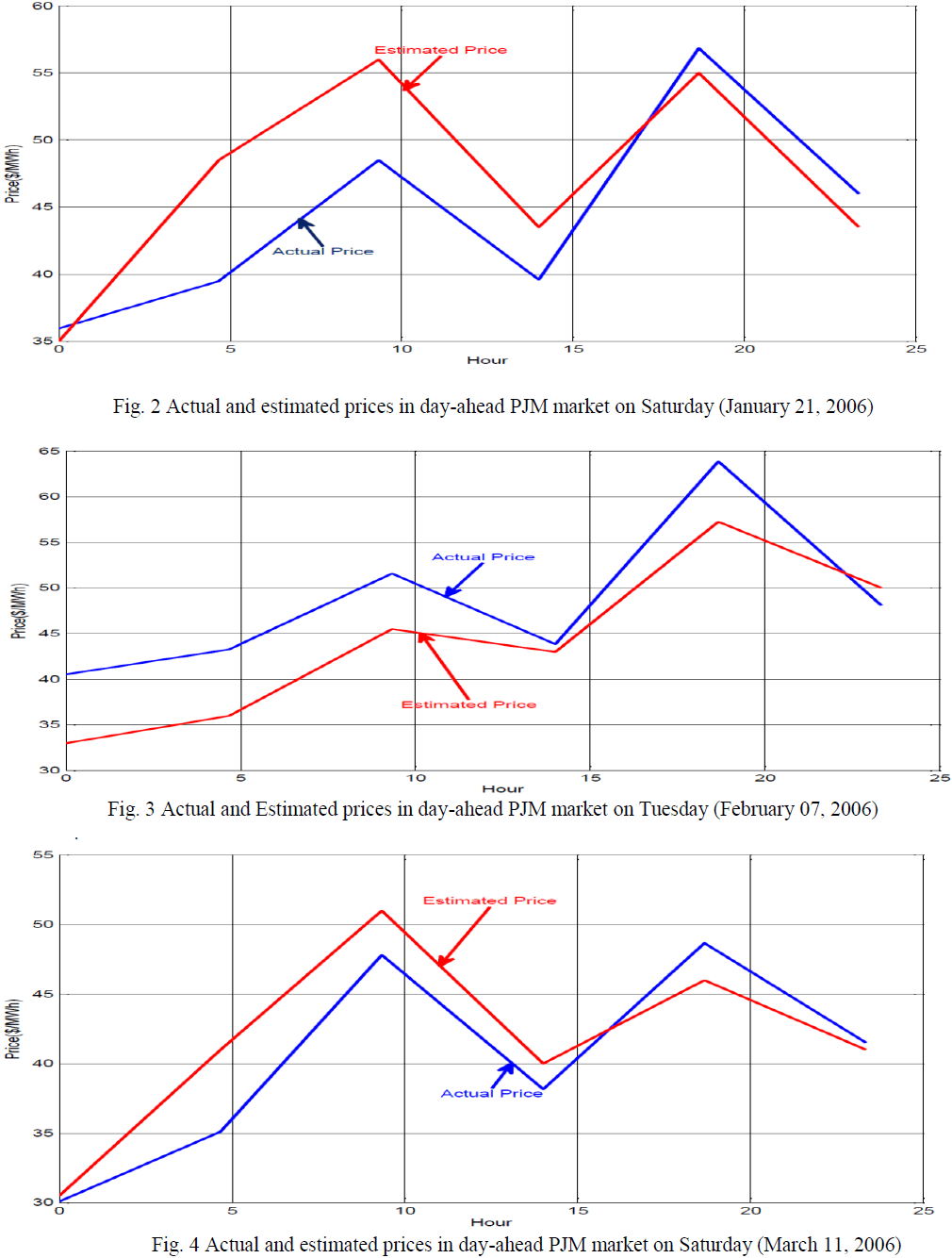 |
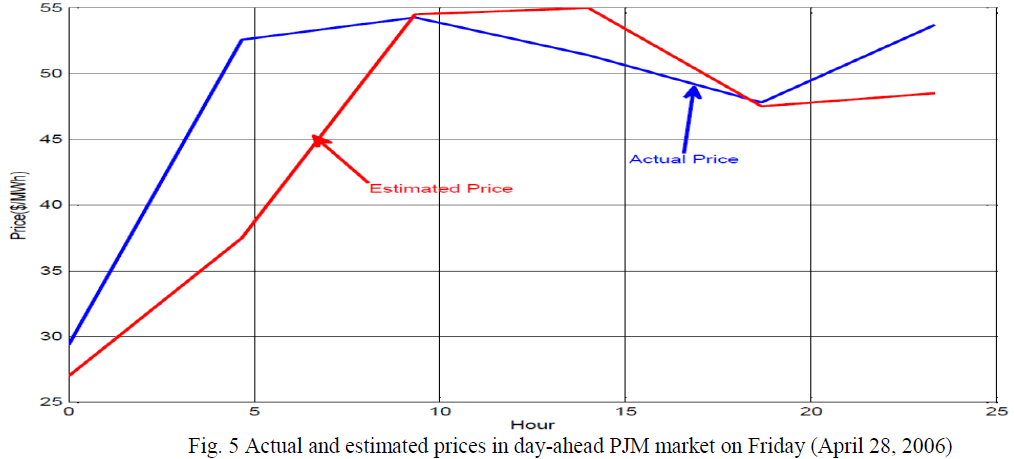 |
| In the proposed design of the FIS model has been applied to predict electricity process of day-ahead PJM market. The testing is carried out by considering the data of July, August, November and December of the year 2006 from the PJM electricity market. Sets of data include hourly price and load data. One day per month (Jan-May) of year 2006 is studied to validate the performance of the Fuzzy Logic. |
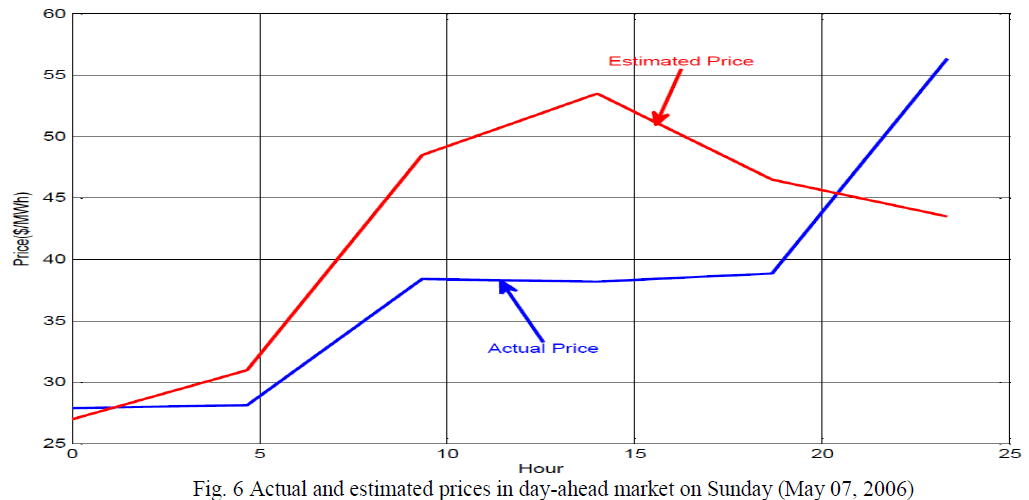 |
| Table I summarizes the numerical results where the comparison of estimation performance of the Fuzzy Logic with similar dayâÃâ¬ÃŸs method is presented. It can be observed from Table I that the daily MAPE of reasonably small value and FMSE of around 5% are obtained for the PJM data, which has coefficient of determination between load and electricity price. |
| Table II that the MAPE values obtained for the weekday (February) in reference range from 9.07%-11.11%, whereas in the current study, MAPE value is around 10% for the weekday. Similarly, for the weekend (May), the MAPE value obtained in our study is much lower (15%) than that obtained in their study. Hence, the Fuzzy Logic method compare favourably well with their approach in weekend and weekday. |
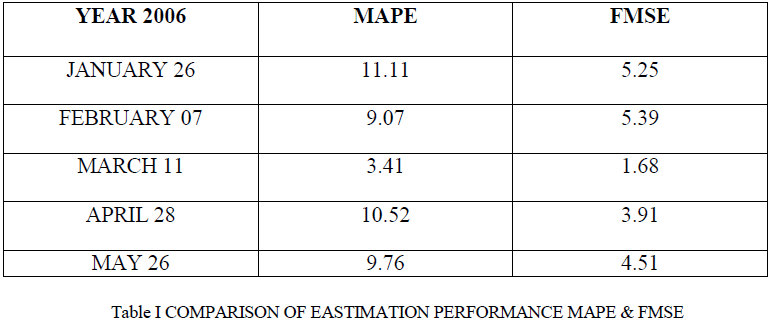 |
 |
References |
|